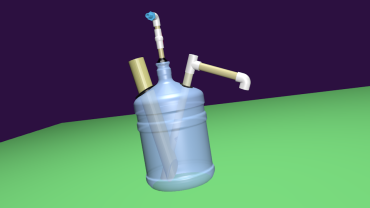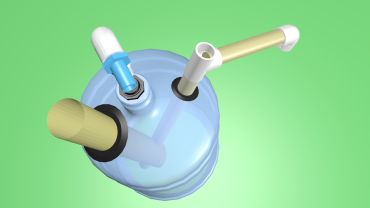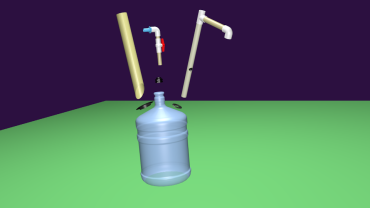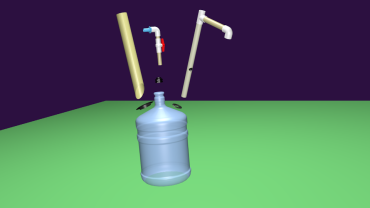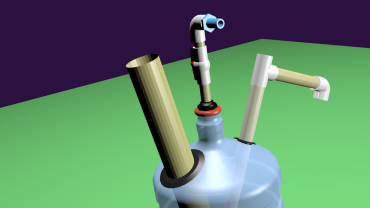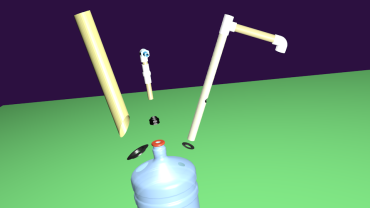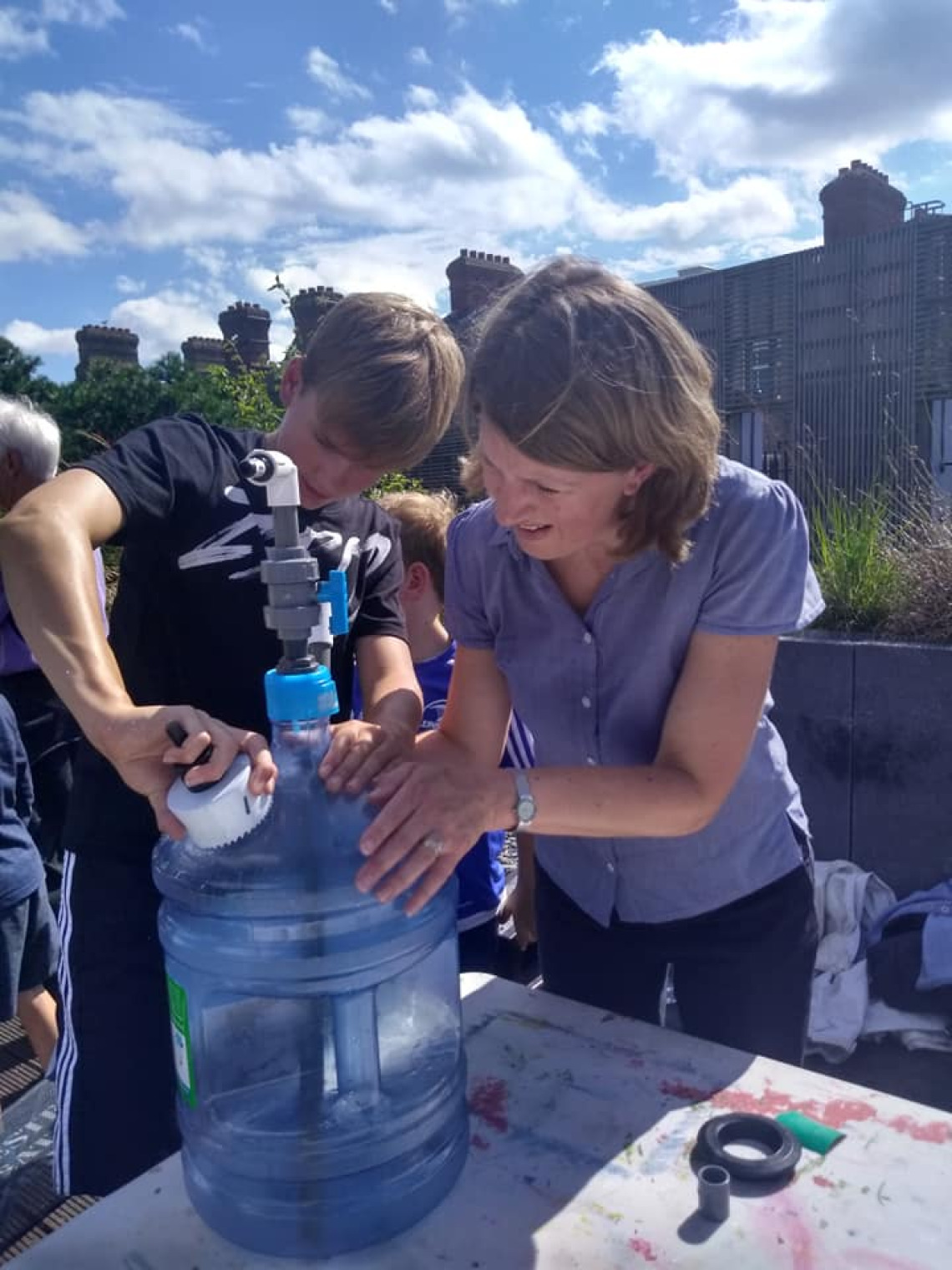
Creating a biodigester is one of the best STEM/STEAM Science Education Activities any teacher could hope for, and making your own Solar CITIES 5 gallon water jug digester is something every kid can do!
The nice thing about a 5 gallon jug digester, made the Solar CITIES way (with our characteristic 3 vertical pipes above the waterline (using the American Sign Language "I love you" sign as a template) is that once you've built the 5 gallon jug version you can simply scale up to any other size of tank, from pickle barrels to 55 gallon drums to IBC tanks and on up to community sized digesters made from huge plastic tanks or even cement.
The other nice thing about our 5 gallon jug digesters is that they are fairly portable and can be used inside the classroom.
Care and feeding:
Remember that the microbes inside any sized digester need time to establish their consortia and colonies and sort out their roles in their new home, so once you have innoculated your digester with fresh manure or septic system powder you need to wait until you get your first flammable gas before you add any food to the digester.
This usually takes 3 to 5 weeks, so be patient.
On the other hand 5 gallon jugs are pretty small and it may be that if you add two or more gallons of starter culture and it is fresh from a farting animal, the microbes might not even "realize" they are no longer in the animal they came from and you may get your first flammable gas within a day or so.
A good thing about the 5 gallon jugs is that you can also fill them with liquid effluent (digestate) from an active larger digester (most people would be happy to give you 5 gallons of active slurry if you give them five gallons of mixed food waste and water to feed their digester!). In this case it is kind of like giving a blood transfusion -- if you don't get too much air into the slurry the microbes won't even 'know' they are in a new tank for the most part, and gas production can resume immediately, with one small caveat: REMEMBER THAT THE BEST GAS PRODUCTION COMES FROM MICROBES THAT HAVE HAD TIME TO ESTABLISH A BIOFILM. Until the microbes have established active biofilms inside their new digester home they are very vulnerable: they can be accidentally washed out as new water or food slurry is added, or they can get overwhelmed by the acids that form as the tank is fed. For this reason we suggest that you still give the digester a few weeks to be "broken in" before you really start feeding regularly.
The importance of fiber
A digester is just a stomach or intestine like digestive system and just like yours it is healthiest when it eats a lot of fiber. Fiber provides surface area for microbes to form their biofilms. Well formed biofilms are like well functioning cities containing a wide variety of microbes each doing their specialized tasks, leading to high efficiency and resiliency.
Some fiber is soluble, coming from the food waste we put in to feed the digester, and leaves with the digestate as you do a new feed. Other fiber is insoluble and stays in the digester permanently. When we are building our digesters we like to put "insoluble fiber" into the stomach of the digester that will be a surface for biofilm growth. We tend to get used mesh bags (like laundary bags or potato sacks) and put them into the digester. In an IBC tank system we fill the mesh bags with any plastic detritus we have (bottle caps work well, as does shredded PTE bottles) or wood chips or straw, filling them just enough that we can still fit the bag into the tank through the lid opening. In a 5 gallon water jug the opening is really narrow so we mostly just put in the bags, either rolled or stuffed in. In some cases we have put sticks into the jug to fill it up with surface area; in Florida we stuff Spanish Moss in because it is abundant. There are many many things you can use, so be creative and see what's already in the environment.
If you don't get the "fiber" in during your build, you can always open the digester lid later and stuff it in. The only rule of thumb is to make sure there is room for bubbles to get out through the opening -- if the opening is clogged with your fiber gas bubbles won't be able to get out and you will think that the digester isn't working. This is one reason we don't put in plastic bags or free floating plastic -- it can clog. Fortunately the water jugs are clear so you can always peek in and see if a clog has developed!
How much to feed
The enemy of biodigesters, like any stomach, is indigestion. We need digesters to digest and if they have indigestion, by definition, they aren't digestion. The usual problem is what we call in our own lives "acid indigestion" which usually comes from eating too much sugar, carbohydrates or fat. You know it from when you get "acid reflux" and burp up that burning sensation and smell. It means you overwhelmed your digestive system and the thing to remember is that the methanogens, the types of microbes that make biogas and indicate full digestion, eat acid but can only do so at a certain rate. The other microbes in the system make the acid that the methanogens eat.
To keep the methanogens, who are at the end of the digestion process chain, from being overwhelmed, we follow what Dr. T.H. Culhane from Solar CITIES calls the "Noah's Archeae" 1/40 rule.
The idea is that it takes roughly 40 days (and 40 nights) for the food wastes put in a digester to be broken down by the Hydrolytic, Acidogenic, Acetogenic and Methanogenic microbes completly. The Methanogens are the Archaea, a special group of single celled organisms that have always been on the earth and are the oldest creatures we know. They were here before the flood and will be here long after, and it is hypothesized that all the other life forms descended from them. They are survivors, but they are sensitive.
Culhane calls them "Noah's Archaea" because if you had to save one group of living creatures from this earth to start all over on another planet, you would want to save the Archaea in your Ark since they could eventually evolve into all the other creatures on a planet, just as they did here.
If you allow 40 days and 40 nights to go by before you feed again, you can be pretty sure that all the food you fed was broken down into methane, carbon dioxide, water vapor and trace amounts of H2S, leaving well digested nutrients in the effluent slurry (which is great for fertilizer).
In batch reactors this would mean feeding the digester once every 40 days, but our Solar CITIES systems are not batch digesters, they are CONTINUOUS FEED digesters, meant to be used every day.
What this means in pracdticality is that you can feed the digester 1/40 of its volume each day.
The concept is fairly simple: If you feed the digester 1/40 its volume today, and 1/40th its volume tomorrow, after 40 days and 40 nights you will have filled the entire digester with food, but by the 40th day the food you fed on the first day will have gone through a full 40 days and 40 nights of digestion, meaning it is ready to come out as gases for cooking and nutrient slurry ready for the garden. On the 41st day the food you fed on day 2 is ready to come out, and on the 42nd day the food you fed on day 3 is done being processed.
Thus we have developed the Noah's Archaea rule of thumb: Only feed your digester 1/40th its volume each day and you should be relatively safe from acid indigestion.
Note that this rule is going to vary with temperature and feedstock -- one of the magical things about healthy nutrition is the way good food keeps our bodies in balance -- as every dentist knows (and should have told you!) eating protien tends to produce alkali or basic fluids that counteract the acid produced from eating carbs and fats, so a balanced diet tends to create a balanced pH in your mouth (protecting your teeth from the acid that makes cavities) and in your stomach (which has its own hydrochloric acid in it too!).
If you are eating a balanced diet chances are that your food waste reflects that fact and you may be able to feed a bit more than 1/40 the volume of your digester. But just to be safe we try to keep within that rule of thumb.
Temperature is super important!!
Note that Culhane's Noah's Archaea rule of thumb is for digesters kept at body temperature or just 5 degrees C lower. In other words it applies safely only to tanks kept between 30 and 37 C (86 to 98 F).
You'll have to dial back your feeding if you keep your biodigester any colder.
Temperature plays a HUGE role in digestion.
The hotter it is the more active the microbes are and the more they can digest.
Cold weather makes them sluggish, particularly the methanogens who are the most temperature sensitive (remember they usually come from the inside of an animal's stomach). The mesophilic methanogens that we use are best adapted to body temperature, 37 C (98 F). In practice, once they are established and get used to their new conditions, they work fine at 30 C (86 F) and the 1/40 rule works well at that temperature.
But every 5 degrees C below that (or 9 degrees F) like at 25 C or 77 F it is best to cut the amount of food waste going in by a third or half.
So at 25 C, 77 F you should think of feeding only 1/60 or 1/80th the volume of your digester. At 20 C (68F) go for as little as 1/120th, and at 15 C (59 F) do as little as 1/200th. Below 15 C (59 F) you should hardly feed at all; 12 C is walk in chiller temperature after all and 5 C (40F) is a refrigerator where nothing is supposed to grow!!! The basic idea is that if your digester gets below 15 C (59 F) it basically is going into hibernation, just like bears preparing for winter.
There have been digesters reported to be working fairly well at 13 C (55 F) but usually these have been innoculated with microbes from lake mud or duck ponds that are "pscyhrophilic" or "cryophilic" (cold-loving) and they still can't take a whole lot of food. In time the microbes in biodigesters adapt to the conditions they are evolving in, so if you are patient and careful you could adapt your digester to different temperatures and feeding rates. That is why we have these "rule of thumbs" rather than hard and fast rules. Nature is always changing and evovling.
Your biodigester is a living creature, a pet domestic dragon. Over time you can "train it" to do more than the rule of thumb suggests. But to be safe, we suggest you start slow.
The calculation is fairly easy though: 5 gallons is 20 quarts, and 1/40 of 20 quarts is simply half a quart. A quart is roughly a liter, so you can feed your 5 gallon digester a half liter of ground up food and water each day ONCE IT STARTS MAKING FLAMMABLE GAS. A half liter is a standard water or soda bottle size, so you can simply cut the top top off of a 1/2 liter soda bottle and use it as a measuring cup for how much food waste to put in.
Because food waste is mostly water, you can either fill the 1/2 liter bottle/cup with food scraps to measure them, and then chop them up and drop them down the feed tube, or grind them in a blender with water (preferred) and pour them down the feed tube. Grinding works much better than simply chucking them down, but if you decide not to grind or blend, use a plunger of some kind to force the chopped up food scraps down the tube.
If the digester does go acid, of course you can do the same thing to it that you do to your own stomach when you get acid indigestion: add a pH buffer. We tend to use an "antacid" like "TUMS" when our stomach's get upset. Biodigesters can be treated with baking soda (sodium bicarbonate) or washing powder (sodium carbonate) or even drain cleaner (sodium hydroxide) or lye (potassum hydroxide) depending on the strength you need. Baking soda and washing powder are of course safer for kids to use.
[[{"fid":"2104","view_mode":"wysiwyg","fields":{"format":"wysiwyg"},"link_text":"Solar CITIES BioJUGester","type":"media","field_deltas":{"1":{"format":"wysiwyg"}},"attributes":{"class":"media-element file-wysiwyg","data-delta":"1"}}]]

